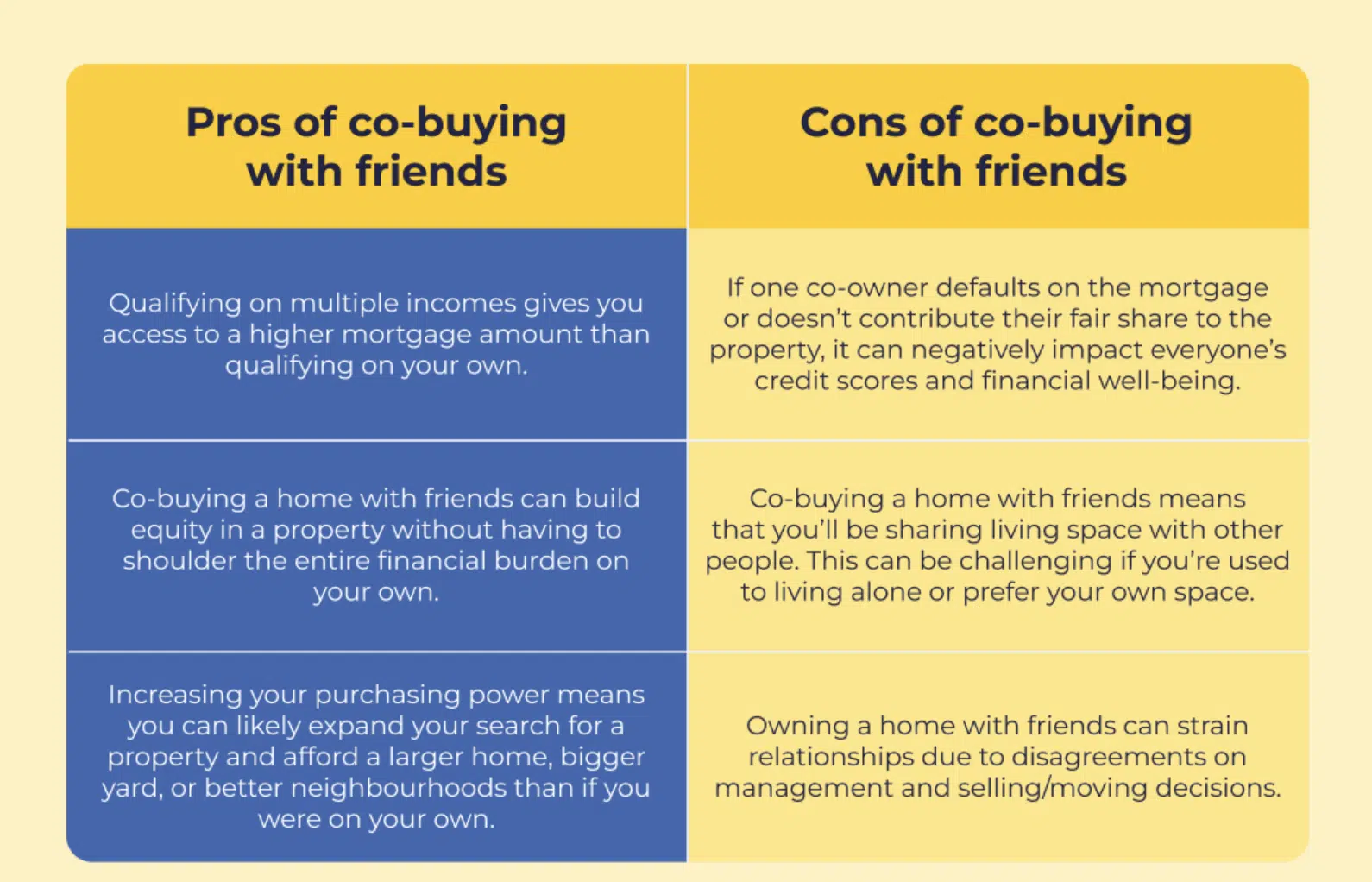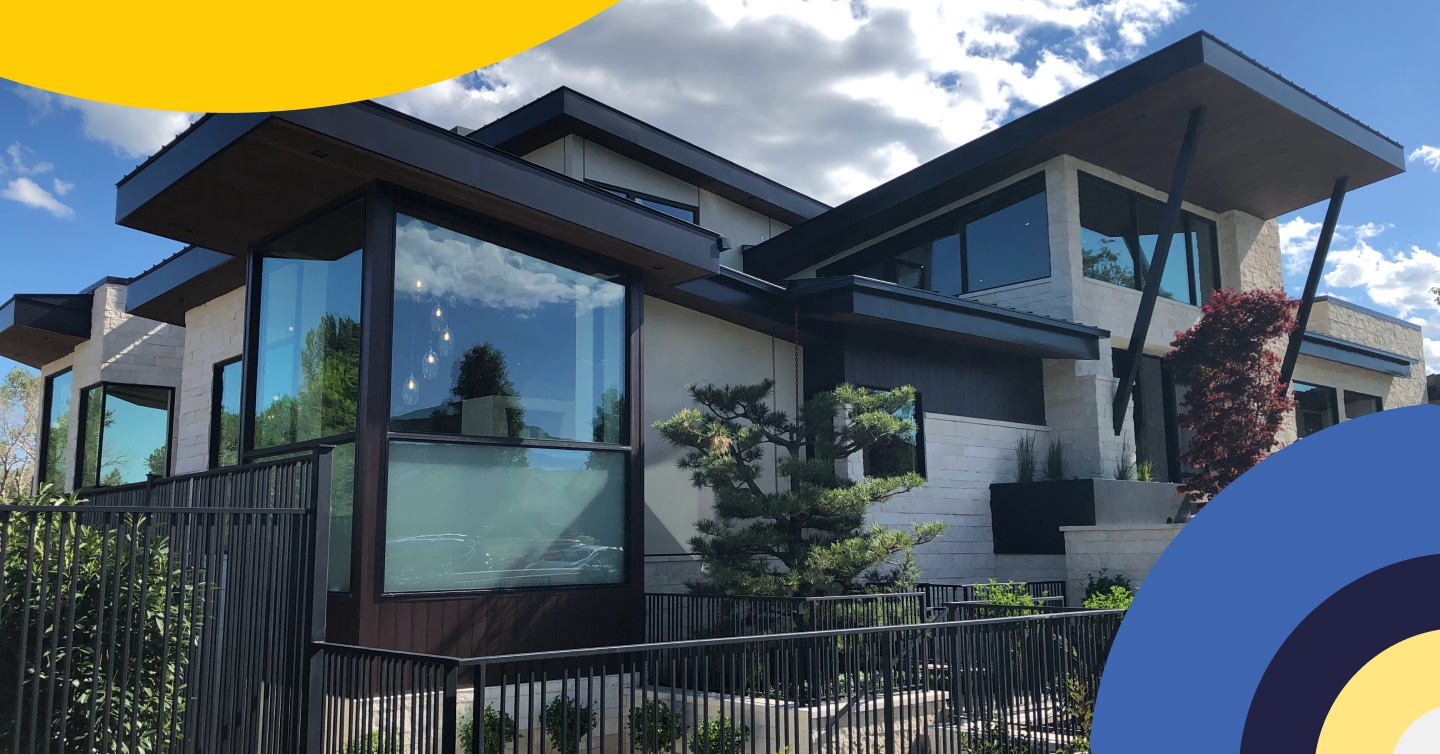Real Estate #Guides #Home Buying #Lifestyle
Real Estate #Guides #Home Buying #Lifestyle
Guide To Co-Buying a Home with Your Friends

Table of contents
Buying a property is a long-term commitment that requires a significant financial investment that many first-time buyers need help saving for. As rents continue to rise along with real estate, renting is no longer the affordable option it once was. If you, like many other Canadians, struggle with this new reality, there are alternative options worth exploring to ease you into homeownership.
Co-buying a home with friends can be a great way to get on the property ladder, providing a more financially feasible option for those that may not have the financial means to compete with ever-increasing home prices. Buying a house with friends offers short and long-term economic benefits, and it can be fun to share this milestone with those closest to you.
Co-buying is becoming more popular as an affordable alternative for Canadians to enter the housing market. However, if you are exploring this option, there will be additional steps for everyone involved to take to protect themselves in a co-ownership arrangement. This post will weigh options to consider when buying property with friends; so you have a plan to ensure the entire process goes smoothly.
Key Takeaways
- Co-buying a home with friends can be a great way to enter the housing market and split the costs of homeownership.
- Create a co-ownership contract that outlines everyone’s responsibilities, financial contributions, and what happens if someone wants to sell or move out.
- To make co-ownership a success, clear communication, financial transparency, and legal advice, plus having an exit strategy in place are important must-haves.
Should You Buy a Home with Your Friends?
As the cost of living and mortgage rates continue to climb, many single people are turning to less-conventional options of splitting home costs. Qualifying for a mortgage on a single income is largely out of reach for the average Canadian.
The concept of co-buying is simple: you purchase a home with others, dividing the expenses and responsibilities.
Typically purchasing with a spouse or leveraging help from family are the more traditional ways of shared ownership. However, teaming up with your closest friends to pool resources can increase your purchasing power and put homeownership within reach if purchasing on your own is out of the question.
Before going down the co-ownership route, having open and honest conversations with your friends about your finances, expectations, goals, and concerns is important. You should also carefully consider the legal aspects of co-buying with friends.
Pros and Cons of Co-Buying a Home
Co-buying can be a smart way to get into the real estate market. However, there are some pros and cons of co-buying with your friends that you will want to consider.
Pros
- Increased purchasing power: qualifying on multiple incomes gives you access to a higher mortgage amount than qualifying on your own.
- Build equity: Co-buying a home with friends can build equity in a property without having to shoulder the entire financial burden on your own. This can be a great investment opportunity, especially if the property appreciates over time.
- Access to better neighbourhoods and larger properties: increasing your purchasing power means you can likely expand your search for a property and afford a larger home, bigger yard, or more neighbourhoods than if you were on your own.
- Reduce financial burden and risk: Co-buying a home with friends allows you to split the costs of homeownership, including the down payment, mortgage payments, property taxes, and maintenance costs.
- Shared costs and responsibilities: Co-buying a home with friends means that you’ll be sharing responsibilities for the property, including maintenance and repairs. This can be helpful if you’re not handy or don’t have a lot of time to devote to home maintenance.
Cons
- Legal and financial risks: If one co-owner defaults on the mortgage or doesn’t contribute their fair share to the property, it can negatively impact everyone’s credit scores and financial well-being.
- Loss of privacy: Co-buying a home with friends means that you’ll be sharing living space with other people. This can be challenging if you’re used to living alone or prefer your own space.
- Disagreements: There’s always the risk of disagreements over how the property should be managed or what happens if someone wants to sell or move out.
- Potential strain on relationships: Co-ownership of a home with friends can put a strain on your relationships, especially if there are disagreements over how the property should be managed or what happens if someone wants to sell or move out. It’s important to have open and honest communication with your co-owners to avoid misunderstandings and conflicts.

How to Buy a House with a Friend
Buying a house with friends requires a slightly different process than purchasing solo or with a spouse. If you’ve decided that homeownership with friends will work for you, here’s how to get started:
1. Determine Your Combined Budget
The first step in co-ownership of a home with friends is determining your collective budget. This will depend on your combined income, savings, and credit scores. You’ll also need to factor in the costs of homeownership, including the down payment and ongoing costs like mortgage payments, property taxes, and maintenance.
2. Find the Right Property
Once you’ve determined your budget, it’s time to look for the right property. It’s important to consider your individual needs and preferences, as well as the needs and preferences of your co-buyers. You should also consider the location, size, and condition of the property, as well as its potential for appreciation.
3. Determine the Ownership Structure
When co-buying a home with friends, you’ll need to determine the ownership structure. There are two common options: joint tenancy and tenancy in common. Joint tenancy means that each co-owner has an equal share in the property and if one co-owner passes away, their share automatically goes to the other co-owner(s). Tenancy in common means that each co-owner has a specified share in the property, which can be based on their financial contributions.
4. Get Pre-Approved for a Mortgage
Before making an offer on a property, you will want to ensure to get pre-approved for a mortgage. This will give you all a better idea of what you can afford and make your offer more competitive. You should also consider working with a mortgage expert who specializes in co-ownership scenarios.
Tenancy In Common vs Joint Tenancy
As mentioned, there are two options for ownership structure when co-buying a home with friends. Here’s a closer look at each option:
Joint Tenancy
With joint tenancy, each co-owner has an equal share and obligation in the property. With joint tenancy, every co-owner of the property must approve before changes such as major renovations, the sale of the home, or a refinance can take place.
If one co-owner passes away, their share automatically goes to the remaining co-owners. Joint tenancy is a good option if you want to ensure that the property goes to the surviving co-owners in the event of death. Or if you trust your co-owners to make the decisions in your best interest in the event of incapacitation.
Tenancy in Common
With tenancy in common, each co-owner has a specified share in the property, which can be based on their financial contributions. Each co-owners share becomes part of their estate in the absence of a will and will pass on to an heir or next of kin (even if not named in a will) who will inherit the share in the property in the event the co-owner passes. Tenancy in common is a good option if you want to have more control over your share of the property and who it goes to in the event of death.
Tenancy in common allows each owner to sell or transfer without needing the consent of other co-owners. Co-owners also have the ability to sell their share to other co-owners through a deed of trust. As a side note, consider that tenancy in common may provide more security when it comes to obligations but will limit access to collateral charge mortgages as they require a co-ownership relationship to be joint on the property title.
Legal Aspects to Consider When Co-Owning
Co-buying a home with friends comes with legal implications, so determining the ownership structure’s important as a first step. This will impact how the property is managed and what happens if one co-owner wants to sell, move out, or if they pass away.
Creating a Co-Buying Contract
A co-buying contract is a legal document that outlines the terms of your co-ownership. It should include the ownership structure, financial contributions, financial responsibilities, and potential scenarios, like if someone wants to sell or move out. It should also address potential disagreements or conflicts that may arise in the future. This document should be created by a lawyer and signed by all co-owners.
To avoid potential disputes, it’s important to include provisions for a buyout or sale of the property in the co-ownership agreement. The agreement should outline the process for selling a co-buyers share, including how to value the property and how to divide the proceeds. It’s also important to have an exit strategy in place in case the co-ownership arrangement is no longer feasible for your personal or financial situation.
Splitting Home Costs
Splitting home costs can be a challenge when co-buying a home with your friends. It’s important to establish clear financial responsibilities upfront and ensure that everyone is contributing their fair share.
- Determine what each co-owner will make as financial contributions based on their income, savings, and ability to pay.
- Divide expenses fairly based on each co-owners financial contribution. This could include mortgage payments, property taxes, utilities, and maintenance costs.
- Keep track of expenses to ensure that everyone is contributing their fair share. Use a shared spreadsheet or app to track all expenses and payments.
- Review expenses regularly to ensure that everyone is still contributing their fair share and make adjustments if necessary.
- Automate expenses into a shared account to ensure timely payments.
- Each cycle put aside a fair share of savings towards future maintenance of your shared property.
What If a Co-owner Wants Out?
It’s important to have an exit strategy in place in case one co-owner wants to sell or move out of the property. This should be included in your co-ownership agreement. Some potential issues that could arise include:
- One co-owner wants to sell or move out of the property.
- One co-owner defaults on their mortgage or cannot contribute their share of the costs.
Some solutions to these issues could include:
- Agreeing on a buyout price in advance.
- Include a first right of refusal clause in your co-ownership agreement, giving the other co-owners the right to purchase that portion of the property first.
- If one co-owner cannot contribute their share of the costs, the other co-owners could consider excluding them from the property title and protecting their interest through a separate legal agreement.
Joint Mortgages: How Do They Work?
A joint mortgage is a type of mortgage where two or more people apply together, qualifying based on their shared income and credit scores, and sharing the responsibility for repaying the loan. When you have a joint mortgage you collectively share all responsibilities of the mortgage contract.
Typically the most common situations have been to have a joint mortgage with a spouse or partner but friends are also becoming more common. A joint mortgage is usually used to increase your odds of qualifying for a mortgage. With home prices at historic highs and interest rates rising, many are not able to get approved for a mortgage on their own so they seek out help from others to secure a mortgage.
How to Make Co-Buying a Success
Co-ownership is similar to a business relationship with friends. Here are a few things that will help make co-buying a success.
Clear Communication
Communication is key when co-buying a home. Before making any decisions, make sure to have open and honest discussions with your co-buyers about your collective expectations, goals, and concerns. It’s essential to establish clear lines of communication and ensure everyone is on the same page before entering into this kind of relationship.
Financial Transparency
Co-buying a home requires financial transparency. Make sure everyone is open to discussing their financial situation, including income, assets, debts, and credit scores. It will also be important to outline how much each person can contribute to the down payment, mortgage payments, and maintenance expenses. Establishing a budget and agreeing on how to split the costs will help keep things transparent.
Legal Advice
Co-buying a home will require legal agreements to protect each co-buyers investment interests. It’s important to consult with a real estate lawyer who can draft a co-ownership agreement that outlines the details of the arrangement, including how the property will be owned, how costs will be shared, and what happens if a co-buyer wants to sell their share. Your real estate lawyer will be able to split the registered land title into the corresponding agreed-upon shares of the property.
Exit Strategy
Everyone must have an agreed-upon exit strategy in place in case one co-buyer wants to sell their share or if the co-ownership arrangement is no longer working. The co-ownership agreement should include provisions for a buyout or sale of the property, as well as how to handle any disputes that may arise if one party wishes to exit the agreement.
Frequently Asked Questions
How can we split costs fairly when co-buying?
You can split costs fairly by establishing a budget and agreeing on how to divide the costs of the down payment, mortgage payments, and maintenance expenses. One way to split the costs is based on each co-buyers financial contribution to the property, or you could split the costs based on the size and value of each co-buyers living space. Or you can split the costs and down payment based on the gross income that each co-owner brings to the qualification of the mortgage application.
What legal aspects should we consider when co-buying a home?
You need a co-ownership agreement or similar document which is a legal contract that outlines the terms of the arrangement, including how the property will be owned, how costs will be shared, and what happens if a co-buyer wants to sell their share or passes away. You will also need to consider how you want the mortgage to be set up: either as joint tenants or tenants in common.
What if one co-buyer wants to sell and the others don’t?
When multiple parties co-buy a property, conflicts can often arise when one of the co-buyers wants to sell and the others don’t. In this situation, it’s important to have an exit strategy in place as part of the co-ownership agreement that outlines the steps to take if this situation arises. This agreement should also state how the property will be valued and how the share can be split up among the remaining co-buyers as their first right of refusal.
Final Thoughts
Co-buying a home with friends can be a great way to enter the housing market collectively and benefit from shared costs of living. However, as with any shared agreement, this will require upfront planning and communication and a formal contract to ensure success. Legal advice should always play an important part when setting up a co-buyer agreement.
If you’re exploring homeownership through co-buying with friends, contact nesto’s mortgage experts to help you get started on your homeownership journey.
Ready to get started?
In just a few clicks, you can see our current rates. Then apply for your mortgage online in minutes!















